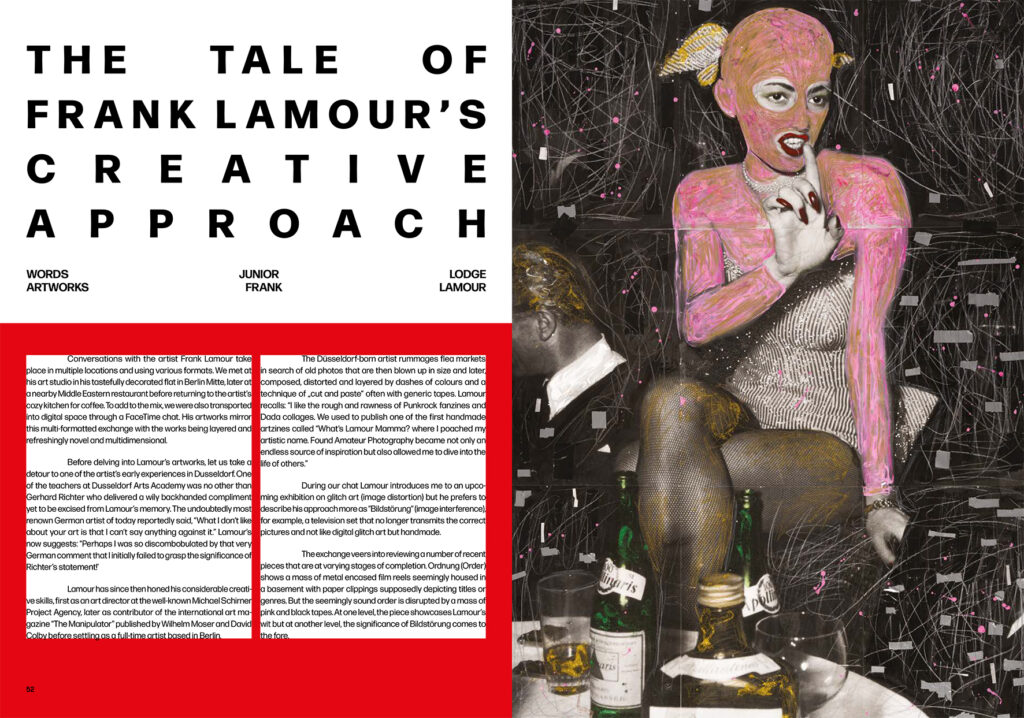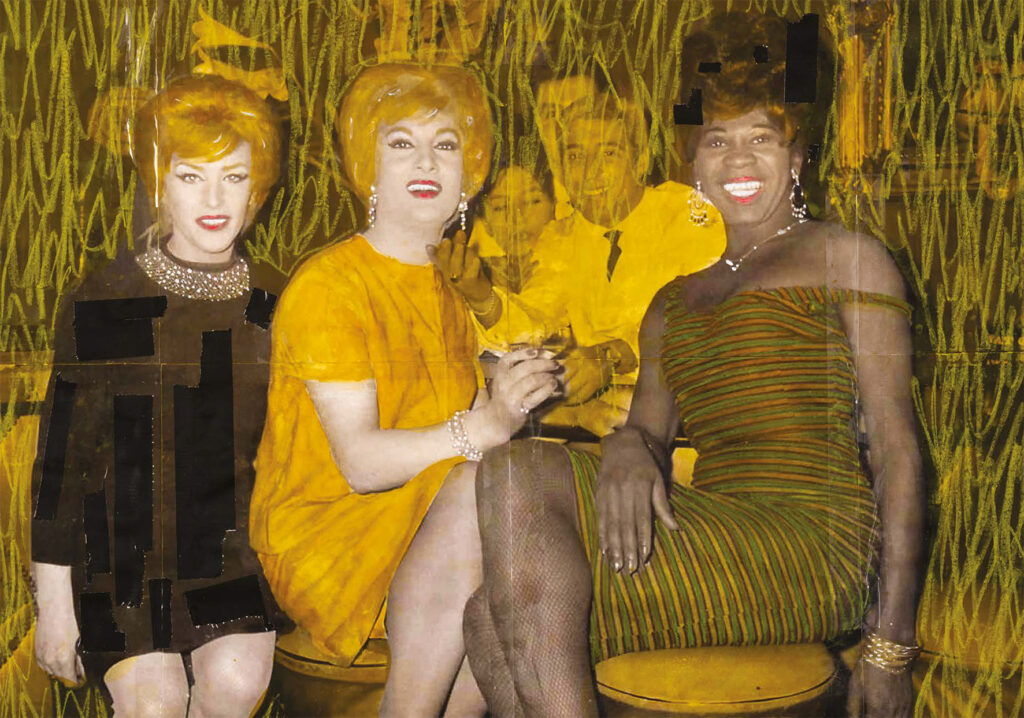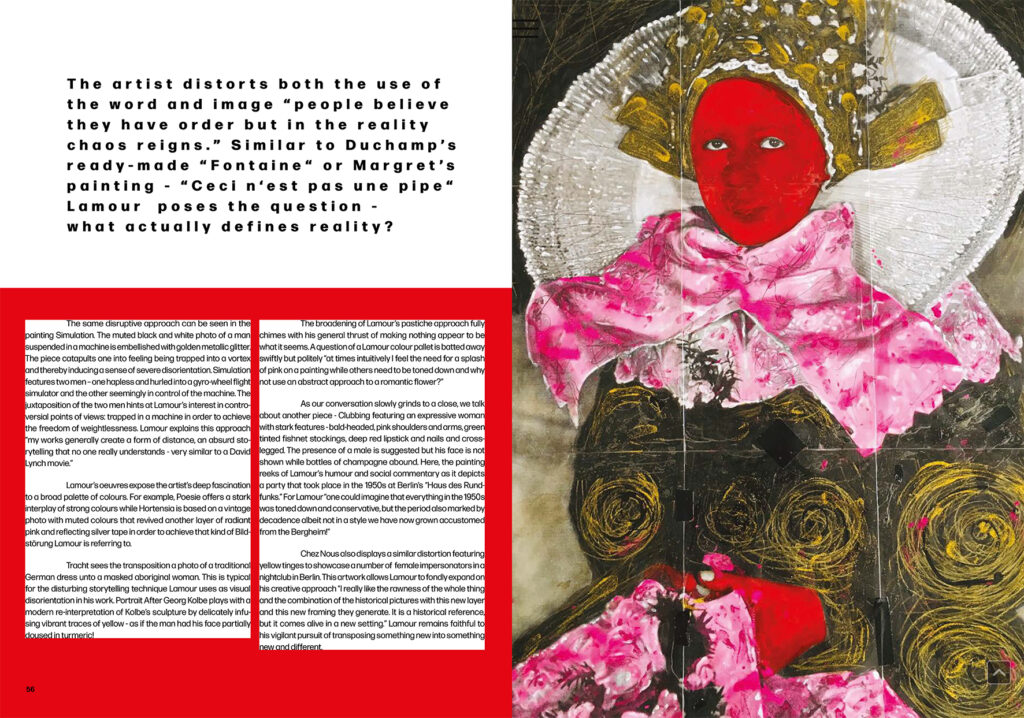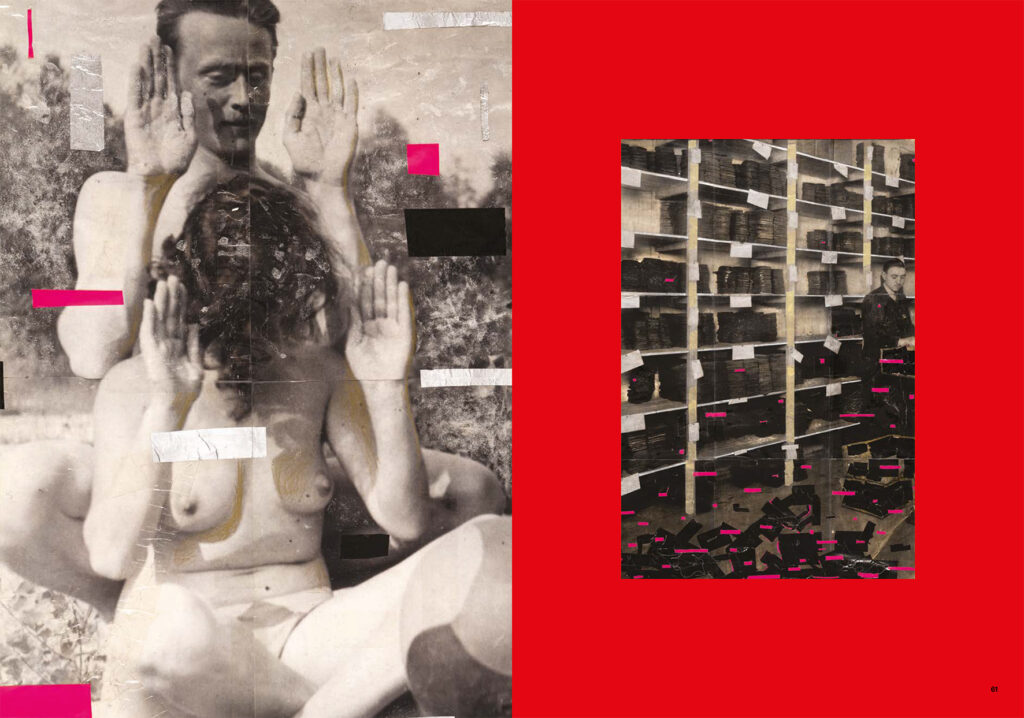




Conversations with the artist Frank Lamour take place in multiple locations and using various formats. We met at his art studio in his tastefully decorated flat in Berlin Mitte, later at a nearby Middle Eastern restaurant before returning to the artist’s cozy kitchen for coffee. To add to the mix, we were also transported into digital space through a FaceTime chat. His artworks mirror this multi-formatted exchange with the works being layered and refreshingly novel and multidimensional.
Before delving into Lamour’s artworks, let us take a detour to one of the artist’s early experiences in Dusseldorf. One of the teachers at Dusseldorf Arts Academy was no other than Gerhard Richter who delivered a wily backhanded compliment yet to be excised from Lamour’s memory. The undoubtedly most renown German artist of today reportedly said, “What I don’t like about your art is that I can’t say anything against it.” Lamour’s now suggests: “Perhaps I was so discombobulated by that very German comment that I initially failed to grasp the significance of Richter’s statement!’
Lamour has since then honed his considerable creative skills, first as an art director at the well-known Michael Schirner Project Agency, later as contributor of the international art magazine “The Manipulator” published by Wilhelm Moser and David Colby before settling as a full-time artist based in Berlin.
The Düsseldorf-born artist rummages flea markets in search of old photos that are then blown up in size and later, composed, distorted and layered by dashes of colours and a technique of „cut and paste“ often with generic tapes. Lamour recalls: “I like the rough and rawness of Punkrock fanzines and Dada collages. We used to publish one of the first handmade artzines called “What’s Lamour Mamma? where I poached my artistic name. Found Amateur Photography became not only an endless source of inspiration but also allowed me to dive into the life of others.”
During our chat Lamour introduces me to an upcoming exhibition on glitch art (image distortion) but he prefers to describe his approach more as “Bildstörung“ (image interference), for example, a television set that no longer transmits the correct pictures and not like digital glitch art but handmade.
The exchange veers into reviewing a number of recent pieces that are at varying stages of completion. Ordnung (Order) shows a mass of metal encased film reels seemingly housed in a basement with paper clippings supposedly depicting titles or genres. But the seemingly sound order is disrupted by a mass of pink and black tapes. At one level, the piece showcases Lamour’s wit but at another level, the significance of Bildstörung comes to the fore.
The artist distorts both the use of the word and image “people believe they have order but in the reality chaos reigns.” Similar to Duchamp’s ready-made “Fontaine“ or Margret’s painting – “Ceci nˋest pas une pipe“ Lamour poses the question – what actually defines reality?
The same disruptive approach can be seen in the painting Simulation. The muted black and white photo of a man suspended in a machine is embellished with golden metallic glitter. The piece catapults one into feeling being trapped into a vortex and thereby inducing a sense of severe disorientation. Simulation features two men – one hapless and hurled into a gyro-wheel flight simulator and the other seemingly in control of the machine. The juxtaposition of the two men hints at Lamour’s interest in controversial points of views: trapped in a machine in order to achieve the freedom of weightlessness. Lamour explains this approach “my works generally create a form of distance, an absurd storytelling that no one really understands – very similar to a David Lynch movie.”
Lamour’s oeuvres expose the artist’s deep fascination to a broad palette of colours. For example, Poesie offers a stark interplay of strong colours while Hortensia is based on a vintage photo with muted colours that revived another layer of radiant pink and reflecting silver tape in order to achieve that kind of Bildstörung Lamour is referring to.
Tracht sees the transposition a photo of a traditional German dress unto a masked aboriginal woman. This is typical for the disturbing storytelling technique Lamour uses as visual disorientation in his work. Portrait After Georg Kolbe plays with a modern re-interpretation of Kolbe’s sculpture by delicately infusing vibrant traces of yellow – as if the man had his face partially doused in turmeric!
The broadening of Lamour’s pastiche approach fully chimes with his general thrust of making nothing appear to be what it seems. A question of a Lamour colour pallet is batted away swiftly but politely “at times intuitively I feel the need for a splash of pink on a painting while others need to be toned down and why not use an abstract approach to a romantic flower?”
As our conversation slowly grinds to a close, we talk about another piece – Clubbing featuring an expressive woman with stark features – bald-headed, pink shoulders and arms, green tinted fishnet stockings, deep red lipstick and nails and cross-legged. The presence of a male is suggested but his face is not shown while bottles of champagne abound. Here, the painting reeks of Lamour’s humour and social commentary as it depicts a party that took place in the 1950s at Berlin’s “Haus des Rundfunks.” For Lamour “one could imagine that everything in the 1950s was toned down and conservative, but the period also marked by decadence albeit not in a style we have now grown accustomed from the Bergheim!”
Chez Nous also displays a similar distortion featuring yellow tinges to showcase a number of female impersonators in a nightclub in Berlin. This artwork allows Lamour to fondly expand on his creative approach “I really like the rawness of the whole thing and the combination of the historical pictures with this new layer and this new framing they generate. It is a historical reference, but it comes alive in a new setting.” Lamour remains faithful to his vigilant pursuit of transposing something new into something new and different.
Words: Junior Lodge